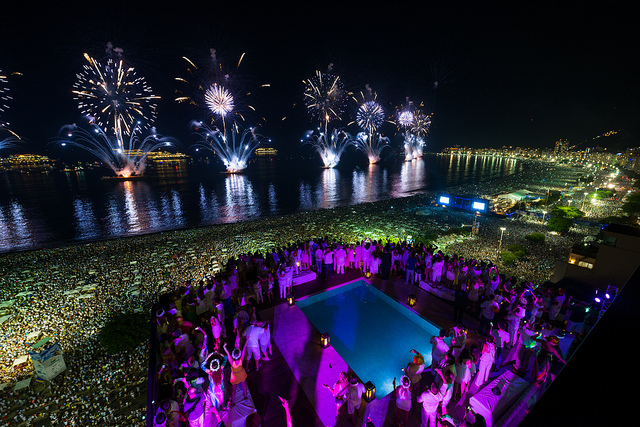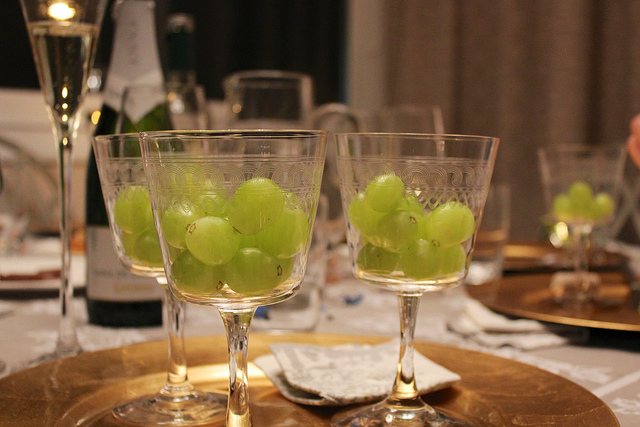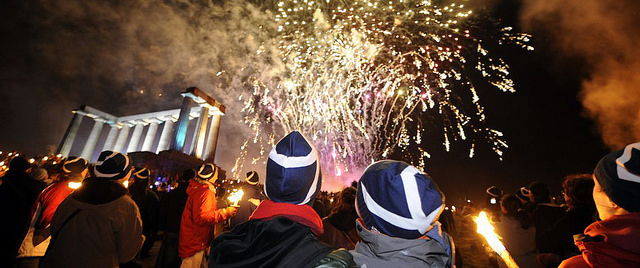New Year’s Eve Celebrations Around the World
New Year’s is just around the corner, putting an end to turkey and chocolate feast and probably putting an end to that glorious time off work. Yes, soon you will have to put on real clothes, not pyjama onesies and venture back out into the world. But before you do, there’s one last party to be held: New Year’s Eve! Although New Year's traditions vary all over the world, a few consistent elements are usually alcohol and kissing, and usually in that order. Let’s take a look at some of the ways New Year’s is celebrated all over the world.
Scotland
Photo via Flickr
In Scotland Hogmanay is celebrated by the locals and indeed all in attendance. The origins of the word Hogmanay are not entirely known, but it may come from the Norman French word hoguinané, which in turn comes from the Old French word aguillanneuf meaning ‘last day of the year’ or ‘new year’s gift’. The origins are viking in tradition, and date back to pagan celebrations of the Winter Solstice (or the Gaelic Samhain), and the celebrations have always been a big deal in Scotland.
To ring in the new year, Scots go ‘first footing’, a practice where groups lead by a dark haired male bearing food, fuel and drink (usually shortbread, whisky, without the 'e', and a piece of coal) go from house to house, wishing a happy new year to the inhabitants and bringing luck upon the household. After a few drinks, it’s on to the next house, to bring more luck! Of course, no New Year’s celebration in Scotland would be complete without singing Robbie Burn’s Auld Lang Syne, a song about friendship and the general passage of time.
Romania
In Romania, New Year’s Eve celebrations start first thing in the morning with children going door to door with bells performing Plugusorul which means ‘the little plow.’ They sing old traditional songs, mainly about bringing luck and good tiding upon the household for the new year. The grownups will do the same that night, though they’ll wear costumes and traditional clothing. After the adult Plugul (large plow), mask dances are held in public squares and gathering points, the most famous is the dance of the bear.
The bear represents death and rebirth in traditional Romanian mythology, so performers will dress in bear suits and dance to drum music to help bring in the new year.

Photo via Flickr
Brazil
Partying in Rio de Janeiro for New Year’s Eve or reveillon should be added to your bucket list and for good reason. Copacabana beach is one of the biggest party spots in the world for New Year’s and you’re sure to have a pretty amazing partying the night away there!
Make sure you choose your outfit correctly though. For the most part, you want white on white on white. Wearing white for New Year’s is believed to scare away evil spirits and bring you luck for incoming year. Now, it’s totally acceptable to throw some colour into the mix, but only for your underwear/bathing suit. When it comes to your undies, the colour you choose brings in a different kind of luck: White is for peace, green means good health, yellow is all about money, red helps attract passion and romance, and purple brings creativity and inspiration. Chose those boxer shorts wisely folks!
Lastly, bring some flowers to your beach party when in Brazil. Lemanja is the goddess of water and she loves receiving gifts of flowers on New Year’s Eve. It’s traditional to throw some into the water for her so she’ll bring you good luck- if the flowers come back, then that means she didn’t accept your gift and you’ve got to try again next year!
Denmark
Hang on to your crockery for New Year’s in Denmark, as one tradition is to throw old plates and dishes at your friends’ door on New Year’s Eve. Supposedly the more broken dishware, the more popular the people in the house! It’d be a great way to get rid of any mismatching plates and bowls, or really just a great way to relieve stress after being trapped with your family over the Christmas holidays.

Photo via Flickr
Spain
Gather up some grapes for New Year’s Eve in Spain. The superstition states that you must eat 12 grapes as fast as possible- the juicier the better. Each grape represents a month of the year, and you’re supposed to eat them within the first 12 seconds of the new year. If you finish all the grapes ( and they were hopefully super juicy), then you’re in for a year of good luck and happiness!
Wherever you are, and whoever you’re with, the folks here at Listen and Learn hope you have a safe and fun New Year’s Eve. If you’re making resolutions, it’s a great time to have a look at some of the language courses we’re offering near you- start your year learning a new language, or improving an old one. Now let’s hear from you! What are your New Year’s Eve traditions?



